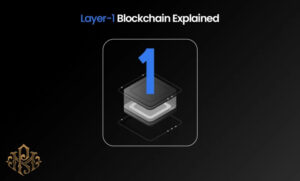
Close



Blockchain technology has revolutionized the way we think about secure and decentralized data storage. One of its main concepts is layer one blockchain. In this Pooyan Music article, we want to discuss the concept of the first layer of the blockchain. Blockchain has enabled new forms of trustless, peer-to-peer transactions that have the potential to disrupt traditional financial and governance systems. At the core of the technology is a distributed ledger maintained by a network of nodes, or computers, each of which validates and adds new transactions to the chain. There are several layers in the blockchain technology stack, each layer adding new features and capabilities to the system. At the base of this stack is layer one, the foundational layer that defines the basic rules and protocols governing the blockchain.
Layer 1 blockchain refers to the blockchain protocol that serves as the foundation of the network. It is a distributed ledger technology (DLT) designed to securely record transactions on a public, immutable and trustless ledger.
Layer 1 blockchains are the most basic type of blockchain that serves as the foundation for other blockchain layers. They are often referred to as the “core” or “foundation” of the blockchain network. Because they provide the infrastructure for all applications and protocols developed on top of the network. They are the only layer responsible for maintaining the distributed ledger, validating transactions, and protecting the network from threats.
Layer 1 blockchain represents the basic network foundation of a blockchain platform. It executes all on-chain transactions and thus acts as the source of truth for the public ledger. For most networks, transaction processing involves capturing the user’s cryptocurrency wallet via asymmetric key pairs and the corresponding coin or token balance. A consensus mechanism, which will be unique to each platform, is used to confirm and finalize the trade or sale. In addition, layer 1 blockchains have their own native token that is used to pay transaction fees or gas fees.

Layer 1 blockchains use various consensus mechanisms to validate transactions and reach consensus among network participants. Common consensus algorithms used in Layer 1 blockchains include Proof of Work (PoW), Proof of Stake (PoS), and Delegated Proof of Stake (DPoS).
Layer 1 blockchains prioritize security by using cryptographic algorithms and decentralized network structures. Blockchain immutability, achieved through cryptographic hashing, ensures the integrity and tamper resistance of transactions recorded on the network.
Layer 1 blockchains face the challenge of scalability. Because they require a large number of transactions without compromising efficiency. Several layer 1 blockchain protocols use innovative techniques such as sharding, sidechains, and state channels to increase scalability and throughput.
Many layer-one blockchains support the execution of smart contracts, which enforce their contracts with the terms of the agreement written directly into the code. Smart contracts allow the automation of contractual agreements, reducing the need for intermediaries and increasing transparency.
Layer 1 blockchains seek to provide basic blockchain functionality. The main goal of any blockchain is to optimize decentralization, security and scalability. The concept of realizing all three is known as the blockchain trinity due to the difficulty of balancing them.
The first layer one blockchains (notably Bitcoin and Ethereum) prioritized decentralization and security at the expense of the scalability of their networks. This has prompted L1 (layer one) developers to change their designs to prioritize scalability or work on alternative “off-chain” solutions.
There are several ways that L1 chains can improve scalability by modifying their native architecture. These include:
With larger blocks, more transactions can fit into each block, thereby increasing network speed. The downside is that the network’s secure computers (nodes) have to increase their hardware requirements, which increases the risk of concentration.
Proof-of-stake (POS) consensus mechanisms are typically faster and less resource-intensive than proof-of-work (POW) consensus mechanisms. However, some believe that this comes at the cost of insufficient security and focus.
Sharding enables Layer 1 chains to divide their data into a predetermined number of discrete data components (called shards), thereby helping to defragment the network and increase transaction speed. However, the communication between sharded chains can be complicated, thereby compromising the security of the blockchain.

Bitcoin, the first and most well-known cryptocurrency, operates on a layer 1 blockchain. Bitcoin uses the PoW consensus mechanism, enabling secure peer-to-peer transactions without the need for an intermediary. Bitcoin’s layer one blockchain is primarily designed to transfer value.
Ethereum is a layer 1 blockchain known for its ability to support smart contracts and decentralized applications. It introduced the concept of programmable money and revolutionized the blockchain landscape. Ethereum’s Layer 1 blockchain uses the PoW consensus algorithm, although it is transitioning to a PoS-based mechanism with the introduction of Ethereum 2.0.
Polkadot is a layer 1 blockchain protocol that focuses on interoperability between different blockchains. It enables the seamless transfer of assets and data across multiple chains. Polkadot uses a unique shared security model and Nominated Proof of Stake (NPoS) consensus algorithm.
Solana is a third-generation blockchain, aiming to solve the scalability problems of L1 blockchains. Solana uses Proof of History (PoH) consensus to achieve transaction speeds of up to 65,000 per second unlike Bitcoin and Ethereum.
Layer 1 protocols represent the foundational layer of the blockchain revolution, which provides the necessary infrastructure for secure and scalable decentralized systems. Using consensus mechanisms, scalable solutions and programmability, layer one blockchains offer unique opportunities for industries and individuals alike. By overcoming the challenges of scalability and becoming interoperable, we can expect an increase in innovative use cases and widespread adoption. As the technology continues to evolve, it is likely that in the near future, layer one protocols will underpin many transformative applications and change the global economic and social landscape.